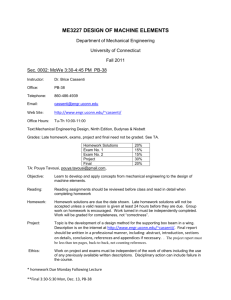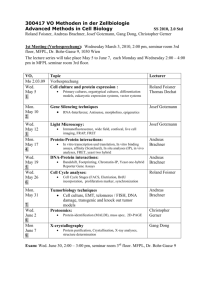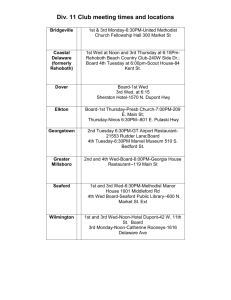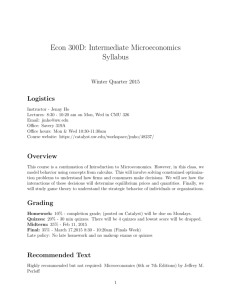FIN 394.1 Advanced Corporate Finance Spring 2009 Jonathan B
advertisement
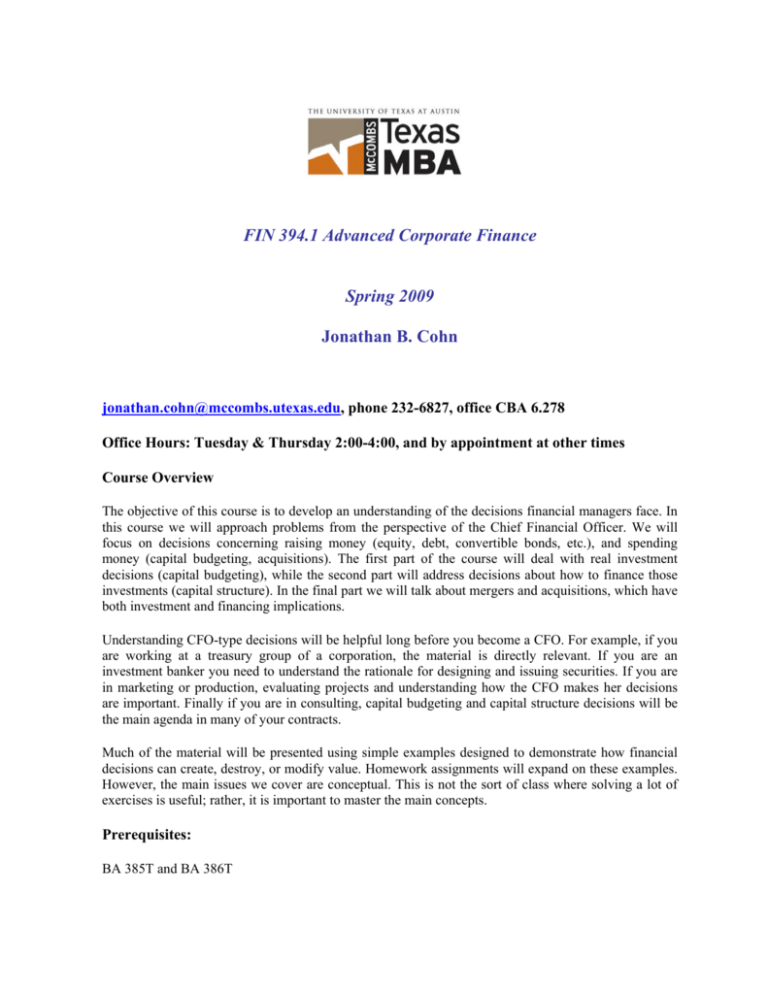
FIN 394.1 Advanced Corporate Finance Spring 2009 Jonathan B. Cohn jonathan.cohn@mccombs.utexas.edu, phone 232-6827, office CBA 6.278 Office Hours: Tuesday & Thursday 2:00-4:00, and by appointment at other times Course Overview The objective of this course is to develop an understanding of the decisions financial managers face. In this course we will approach problems from the perspective of the Chief Financial Officer. We will focus on decisions concerning raising money (equity, debt, convertible bonds, etc.), and spending money (capital budgeting, acquisitions). The first part of the course will deal with real investment decisions (capital budgeting), while the second part will address decisions about how to finance those investments (capital structure). In the final part we will talk about mergers and acquisitions, which have both investment and financing implications. Understanding CFO-type decisions will be helpful long before you become a CFO. For example, if you are working at a treasury group of a corporation, the material is directly relevant. If you are an investment banker you need to understand the rationale for designing and issuing securities. If you are in marketing or production, evaluating projects and understanding how the CFO makes her decisions are important. Finally if you are in consulting, capital budgeting and capital structure decisions will be the main agenda in many of your contracts. Much of the material will be presented using simple examples designed to demonstrate how financial decisions can create, destroy, or modify value. Homework assignments will expand on these examples. However, the main issues we cover are conceptual. This is not the sort of class where solving a lot of exercises is useful; rather, it is important to master the main concepts. Prerequisites: BA 385T and BA 386T Books and Materials: (Required) Textbook: Mark Grinblatt and Sheridan Titman, Financial Markets and Corporate Strategy, 2nd Edition (Irwin/McGraw-Hill, 2002) (Required) Course Packet • You can obtain the course packet from the copy center on the third floor of GSB. (Required) Lecture Notes and Class Handouts • These will be available on Blackboard as the course develops. The following books are NOT required. I have listed them here in case you wish to get a different perspective on a topic. Alternatively, once you land the CFO job, you might want something for the bookshelf. • • • • Robert C. Higgins, Analysis for Financial Management (7th ed.) Irwin/McGraw-Hill, 2004. Richard A. Brealey, Stewart C. Myers, and Franklin Allen, Principles of Corporate Finance (8th ed.), Irwin/McGraw-Hill, 2006. Stephen A. Ross, Randolph W. Westerfield, and Jeffrey F. Jaffe, Corporate Finance (6th ed.), Irwin/McGraw-Hill, 2002. Joel M. Stern and Donald H. Chew, Jr. eds. The Revolution in Corporate Finance, (4th ed.), Blackwell Business, 1998. Other Sources • The Wall Street Journal, Financial Times, the New York Times business section, the Economist, or Business Week are all recommended (pick one). We will cover the conceptual material to help you think through financial decisions. However, details of a particular issue a recruiter might ask your thoughts on may come from the press. Grading: • Homework Assignments and Case Write-ups 25% Class Participation 10% Midterm Exam 25% Final Exam 40% There is one exception to the above grading rule. If your final exam score is in the top 20% of the score distribution of this section, you will get an A in this course, regardless of your midterm and assignment scores. The only condition for this is that you have been a “good citizen,” that is, participated in lectures, handed in homework assignments and case write-ups, and took the midterm exam. • You may work in groups of up to four for homework assignments and cases. Please submit one write-up per group, and make sure to indicate all group members’ names on the first page. There is no need to work with the same group of people throughout the term. Assignments must be handed in at the start of the class in which it is due. Late assignments will not be accepted. • Homework assignments include applied problems and exercises. Case write-ups should be memos of at most five double-spaced pages (excluding exhibits and appendices). For each case, I will assign some specific questions to be addressed. Grading of case reports will be based on how well you justify your arguments and support them with detailed and careful analysis. You should think of case reports as presentations you make to a board; to receive credit, your arguments must be convincing. How to do well on the exams: • Problem sets and in-class exercises provide the best preparation for the exams. • The exams will be closed book. The final exam will cover the entire course, although it will be weighted toward the material we will cover after the midterm. • If you miss an exam due to a personal emergency, please try to inform me in advance. Even in case of a personal emergency no make-up exam will be administered for the midterm. In that case your final exam will count 65% of the grade. In any other circumstance missed exams will be assigned zero points. Schedule: A tentative schedule appears below. Please note that like an airline, I reserve the right to alter the schedule as we go. Articles and Cases Included in the Course Packet Articles 1. Stewart Myers, “Finance Theory and Financial Strategy,” Midland Corporate Finance Journal 5, 1987. (Reprinted in Stern and Chew, 2003). 2. Alex Triantis and Adam Borison, “Real Options: State of the Practice,” Journal of Applied Corporate Finance 14-2, 2001. (Reprinted in Stern and Chew, 2003). 3. Thomas Copeland and Peter Tufano, “A Real-World Way To Manage Real Options,” Harvard Business Review, March 2004. 4. John R. Graham and Campbell R. Harvey, “Theory and Practice of Corporate Finance – Evidence from the Field,” Journal of Financial Economics 61, 2001. 5. John R. Graham, “Estimating the Tax Benefits of Debt,” Journal of Applied Corporate Finance, 141, 2001. 6. “Vanderbilt University Roundtable on the Capital Structure Puzzle,” Journal of Applied Corporate Finance, 11-1, 1998. 7. “Stern Stewart Roundtable on Capital Structure and Stock Repurchase,” Journal of Applied Corporate Finance, 14-1, 2001. (Reprinted in Stern and Chew, 2003). 8. Tim C. Opler, Michael Saron and Sheridan Titman, “Designing Capital Structure to Create Shareholder Value,” Journal of Applied Corporate Finance, 10-1, 1997. 9. Bengt Holmstrom and Steven N. Kaplan, “The State of U.S. Corporate Governance: What’s Right and What’s Wrong?” Journal of Applied Corporate Finance, 15-3, 2003. 10. Brian J. Hall, “Six Challenges in Designing Equity-Based Pay,” Journal of Applied Corporate Finance, 15-3, 2003. 11. David Mayers, “Convertible Bonds: Matching Financial and Real Options,” Journal of Applied Corporate Finance, 13-1, 2000. (Reprinted in Stern and Chew, 2003). 12. Robert F. Bruner, “Where M&A Pays and Where It Strays: A Survey of the Research,” Journal of Applied Corporate Finance 16-4, 2004. 13. George Andrade, Mark Mitchell, and Eric Stafford, “New Evidence and Perspectives on Mergers,” Journal of Economic Perspectives, Vol. 15-2, Spring 2001, pp. 103-120. Cases 1. 2. 3. 4. 5. 6. 7. Sky Television vs. British Satellite Broadcasting (HBS 9-792-039) Arundel Partners (HBS 9-292-140) Dixon Corporation: The Collinsville Plant (HBS 9-298-165) Massey Ferguson, 1980 (HBS 9-282-043) MCI Communications Corp., 1983 (HBS 9-284-057) Paramount Communications Inc. 1993 (Casenet South-Western College Publishing) Paramount Communications Inc. 1994 (Casenet South-Western College Publishing) Class Schedule & Assigned Readings Date Topic (numbers represent sections in Grinblatt & Titman’s textbook unless otherwise indicated) January Wed. 21 Introduction; Foundations of Valuation of Real Investments (10.1, 10.2, 10.4, 10.5, 10.6) Mon. 26 Valuing Risky Projects (7.1 [forwards and futures only], 11.8, Ch. 5 and 6, 11.2, 11.3, 11.4, 11.5,12.3) Wed. 28 Valuing Risky Projects - continued February Mon. 2 Valuing Risky Projects – continued Wed. 4 Case 1: Sky TV vs. BSB Mon. 9 Valuation of Financial Options (Ch. 8) – Homework 1 due Wed. 11 Real Options and Corporate Strategy (12.1, 12.2, Articles 1, 2, and 3) Mon. 16 Real Options and Corporate Strategy – continued Wed. 18 Valuation and Taxes (13.1, 13.2, 13.3) Mon. 23 Valuation and Taxes – continued (Article 4 Part I) – Homework 2 due Wed. 25 Case 2: Arundel Partners March Mon. 2 Case 3: Dixon Corporation: The Collinsville Plant Wed. 4 Valuation review – Homework 3 due Thu. 5 Midterm Exam, 6-8pm, room TBA Mon. 9 No class – Plus trips Wed. 11 No class – Plus trips Mon. 16 No class – Spring break Wed. 18 No class – Spring break Mon. 23 Modigliani-Miller: Capital Structure in Perfect Markets (14.1, 14.2, 14.3, 15.2) Wed. 25 Taxes and Bankruptcy (14.4, 14.5, 15.3, 15.5, 15.6, Article 5) Mon. 30 Bankruptcy and Conflicts between Debt Holders & Equity Holders (16.1, 16.2, 16.3, 16.4) April Wed. 1 Bankruptcy and Conflicts between Debt Holders & Equity Holders – continued Mon. 6 Stakeholders and Capital Structure (Chapter 17, Articles 6, 7 and 8) – Homework 4 due Wed. 8 Case 4: Massey-Ferguson Mon. 13 Corporate Governance and Managerial Compensation (Ch. 18, 10.3, Articles 9 and 10) Wed. 15 Information Conveyed by Financial Decisions (Ch. 19) Mon. 20 Information Conveyed by Financial Decisions - continued, Convertibles (Article 11, Article 4-Part II) – Homework 5 due Wed. 22 Case 5: MCI Mon. 27 Mergers and Acquisitions (Chapter 20, Articles 12 and 13) Wed. 29 Mergers and Acquisitions - continued May Mon. 4 Case 6: Paramount 1993 Wed. 6 Case 7: Paramount 1994 Homework 6 due





